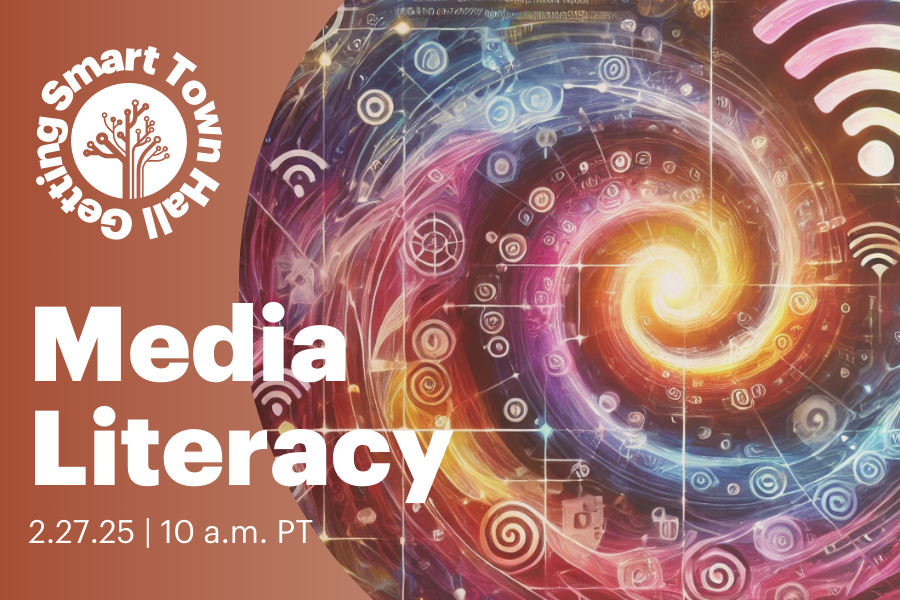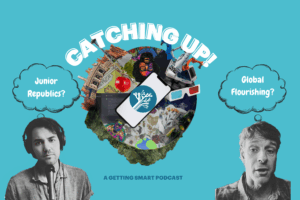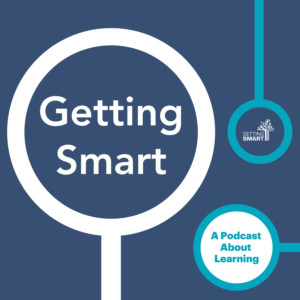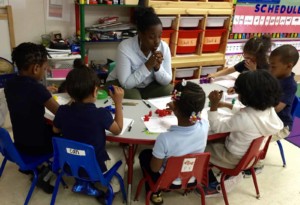Town Hall: Media Literacy
Key Points
-
Media literacy is essential in navigating the complexities of AI-generated content, requiring critical thinking and discernment skills.
-
Educational policies and frameworks must evolve to integrate media literacy across curricula, equipping students with tools to critically engage with media.

In our latest Town Hall, Nate McClennen leads a conversation on the critical topic of media literacy in the age of artificial intelligence. We explore how educators and learners alike can adapt to this evolving landscape, all while touching on the foundational elements of media literacy, highlighting resources like the National Association of Media Literacy Educators (NAMLE) and sharing tools such as Ad Fontes Media’s bias chart.
The event dives deep into the intersection of AI and media, introducing Getting Smart’s categorizing of media: Media 1.0, Media 2.0, and the rapidly approaching Media 3.0, where AI agents autonomously generate content. This shift underscores the importance of equipping young people with the skills to critically assess and engage with media. Vriti Saraf, CEO of Ed3 DAO, shares insights into the implications of AI-generated content and the logical fallacies that can arise from it, emphasizing the need for robust critical thinking skills. The discussion also highlights the role of policy in advancing media literacy, with organizations like Media Literacy Now advocating for educational frameworks and standards.
In the final segment, we explore the “superpowers” necessary for thriving in an AI-driven world, such as self-governance and cognitive resilience. The podcast underscores the dual nature of media as both a tool for empowerment and a potential source of manipulation, urging listeners to foster a balanced approach to media consumption. As we call for schools and districts with exemplary media literacy programs to share their practices, the conversation closes with a call to action for educators, policymakers, and families to prioritize media literacy as a key component of education, ensuring future generations are well-equipped to navigate the information-rich landscapes of tomorrow.
Outline
- (00:00) Introduction and Orwell’s Quote
- (01:31) Media Literacy Tools and Resources
- (04:47) Policy and Media Literacy
- (06:06) Foundations of AI and Media
- (14:55) Logical Fallacies in AI Media
- (19:36) Superpowers for the Age of AI
- (24:46) Critical Thinking and Media Literacy
- (30:23) Conclusion and Call to Action
Nate McClennen: I love this quote from Orwell: “The further society drifts from truth, the more it will hate those who speak it.” So we know even by this short exercise that this is a challenge.
Media literacy is a challenge. And so we’re getting smart. None of us are media literacy experts, but we’re really curious about learning about what’s happening out in the ecosystem, especially the K-12 space, and also higher education, about how to help a generation of humans adapt to a massive information overload, much of which may not be true.
So, we’re going to talk a little bit through today. We’ll do a couple of different sections, and after each section, we’ll pause and give everyone a chance to reflect to help inform our collective knowledge around this. Feel free to push back when you see things that you don’t agree with.
Nate McClennen: So let’s start with what is media?
It feels pretty obvious, but media is anything that’s communicated. All information and communication are trying to make us do something—to change our opinion, to make us feel a certain way, to evoke an image, to evoke a story, to convince us of something. So, media is a really broad set of anything that’s communicated—all information. So just setting a baseline there. The National Association of Media Literacy Educators is a great resource, and they define media literacy as the ability to access, analyze, evaluate, create, and act using all forms of communication.
So just think about these as our basic standing definitions, and then think about what young people and adults need to be media literate.
Media Literacy Tools and Resources
Nate McClennen: And so I really like this. If you haven’t jumped onto Ad Fontes Media website, it’s free. You can play around and zoom in on this tool.
But this tool is really interesting. It takes all news sources out there that they’re evaluating and evaluates them for left versus right political bent, and then it evaluates them on a scale from inaccurate and fabricated information at the lower left to original and fact reporting with high effort at the top.
There’s an obvious mathematical correlation here. In my old days, I used to teach math, and this would be a great modeling exercise for an inverse parabola, because when you look at it and you actually map it out, it puts a perfect curve here. And what that means is when we’re talking about media, if we can remember one of the big takeaways from this, it’s that the more someone’s trying to convince you of something, the lower the reliability of that information. So the center, which is least extreme, is probably the most reliable.
So when you think about tools, if you’re an educator or working with schools or districts, think about helping young people understand that curve of reliability. The more extreme, the less reliable it is when you look at the analysis.
I think this also is a great news literacy project. We’re going to reference a bunch of different organizations that are doing really incredible work in this space, and so we’ll list them all in the show notes. You can go and reference them, and each of those websites has tons of resources, so we encourage you to go and explore.
Nate McClennen: This report from 2024 is “News Literacy in America.” I wanted to pull out a few specific things from this. They surveyed a bunch of students—1,100 students—so it was statistically significant. This is from last May 2024, so a little under a year ago.
A couple takeaways: teens want media literacy instruction included in their education, but most are not getting it, indicating a deficit in instruction. Regardless of age, teens struggle to distinguish between different types of information. Even we struggle to figure out true versus false, AI versus human, right? So, it is becoming harder and harder to understand and distinguish between different types of information.
Around the press, nearly half of teens in this survey think the press does more to harm democracy than protect it. Regarding conspiracy theories, most teens on social media encounter them and are inclined to believe one or more. When it comes to AI, only 36 percent of teens report having at least a fair amount of trust in AI tools to generate accurate information, while half report having little to no trust in the accuracy and fairness of these AI tools.
Yet, they, along with all other humans in the world accessing technology, will be exposed to more and more AI-generated media. So when you think about this, this report is fascinating to consider: this is the next generation of individuals that will grow up to become adults. They’ll be voting, contributing, deciding to participate or not, and these are the things they’re growing up with. We have a prerogative and an obligation to think about how to enhance the superpower of being really media literate, which we think is really important.
Policy and Media Literacy
Nate McClennen: Policy is catching up, which is good news. Policy isn’t the solution for everything, but it is a top-down approach to media literacy. If you want to keep up to date on media literacy policy, Media Literacy Now is a great organization. We just released a blog post on them after doing an interview with Erin McNeil, who runs that organization, and she’s tracking and trying to understand with her organization all the different policies out there.
I would note that not a lot of states have specific curriculum policies to say, “Hey, this is what you need to do,” it’s not written into the standards, etc. Only a few states, like Georgia, New Jersey, and Delaware, have a full requirement to include instruction in K-12 classrooms.
And the other piece is that even when the whole country is filled with purple, which ideally it may be, I think there’s more and more laws and legislation being presented. The implementation of that, we, of course, know is much slower. So we have a long road in terms of creating media-literate students and helping develop them into media-literate adults, as we ourselves struggle with this as well.
We’re going to go on to the next set of foundational pieces. So we just identified media. What is media? What is media literacy?
Foundations of AI and Media
Nate McClennen: So let’s talk a little bit about AI and media and how it’s impacting. Some of you already predicted this through your chat comments. So we are thinking about this in three different phases of media: Media 1.0, Media 2.0, Media 3.0. We just want to give a few examples of this. And this helps contextualize the world we’re in.
Nate McClennen: Most of human history has been spent in Media 1.0. Humans generate media content. We, as humans, have control, and we’re doing something. We’re writing something down, telling a story, creating a video, putting something online.
Very recently, over the last couple of years, we’ve been creating media. We’ve been in Media 2.0, where humans use AI to generate media content. We’ll give some examples of that. Then Media 3.0, AI agents, we’ll talk about that. So this is our sequence of what’s happening. We’re now approaching rapidly this Media 3.0 world.
Challenges of AI-Generated Media
Nate McClennen: Obvious to most of us on this call, but just a reminder: there was more data created in the last three years than in all of history. Humans generate media content in Media 1.0, but we are now generating it at a massively faster rate than ever before. Some of that’s due to population, technology, and the internet. So understanding that every single minute, massive volumes of information are being produced, makes it harder for students to be media literate in our world.
Media 2.0: Humans using AI to generate media content. Most of you have probably experimented with Notebook LM out of Google Labs. If you haven’t, try it. You can feed it various materials, PDFs, and videos, and it will create a podcast for you as one of the features. Whether the podcasts are true or a good representation of the material is hard to discern, but the AI personas doing the podcast sound very human, and they just added a new feature where you can jump into that podcast and join it. Fascinating. How does that help with media literacy? Using humans to generate media content with AI, such as a new podcast, is an example.
The last one, which convolutes the issue of media literacy even further, is Media 3.0, which is AI agents. Agents operating autonomously, given directions by humans, but then making decisions by themselves and creating media.
This is already happening. It’s not science fiction. You can go on Twitter or X, but the app itself is called a Twitter AI agent, and it can run an account for you. It can reply, post, like, and generate whatever you wish. It can operate autonomously on social media. Imagine that for any type of media generation. This is Media 3.0: large numbers of AI bots, AI agents generating media content. This becomes even more important for young people and adults to understand who is generating what.
I’m going to pause for a second and see what’s happening here. Diane, you’ve been chatting a lot, so you get the honor of coming off the mic. Your last comment is interesting. What’s the good reminder for us?
Diane Laufenberg: Yeah, I just really try to help people focus on what are the human skills we need to be working on, regardless of the tech that shows up.
This has been a drum I’ve been beating for two decades, and it’s nothing new. But to your earlier point, the volume, the pace, just the pace of change, the pace of conversation, the pace of content is so ramped up and so big that it sometimes feels like we just have to give in to the machine or give in to the thing that’s overwhelming, and there are really core human qualities that are very difficult for machines to get good at, which are inquiry, genuine questioning, authenticity, communication, and robust collaboration.
Those things are hard to always make happen in a machine-based world. So I’m just always trying to bring people back to, yes, shiny, awesome, new, cool. However, that’s going to be running you unless you, as a human, are running it. And in order to do that, you’ve got to have this set of skills because we’re not done. This isn’t done. We’re not done. This isn’t the end. This is just going to keep happening. So what do we need to do as humans to stay up to speed with it?
Nate McClennen: I totally agree and really appreciate that comment. There is a need to be media literate to keep up with the shiny and new, obviously, that’s how we operate in the world, and there’s an equally important need to double down on the uniquely human skills that we think are important for the world and our own survival, right? And I think, unfortunately…
Diane Laufenberg: Media literacy is in there, though, too. I wouldn’t say that’s a different…
Nate McClennen: It is one of the important skills, yes.
Diane Laufenberg: Because you need to be inquiry in. You need to have good communication.
Nate McClennen: Yeah, and the challenges, as we’ve been talking about, are the volume has increased and the access has increased. All right, great. Let’s pivot. I’m going to hand it off to you.
Vriti Saraf: Hi, everyone. I’m Vriti Saraf. I’m the CEO and co-founder of Ed3 DAO, a nonprofit that helps educators skill up in emerging technology through courses, online courses, in partnership with universities, a global community of practice, some resources, as well as R&D.
Awesome. I don’t know if you all saw Mark Zuckerberg’s announcement in the last two weeks or so. He announced that across all of their platforms, Facebook and Instagram, they will no longer be fact-checking anything that goes on their platforms. They will also no longer be policing any type of slander or anything offensive. What that means is that not only because of that, but because of AI-generated content, there is this huge influx of nutrient-poor information and what we call infobesity.
There’s just a lot of information coming at us, not just students, but all of us as humans, that is nutrient-poor, potentially untruthful, and potentially harmful. That’s the thing we need to counteract. We need to counteract the infobesity. Since 2023, there’s been a thousand percent increase in AI-generated content online, and fake news is six times more likely to be spread than the truth. You can see how there is a huge potential for all of us to be consuming information that is nutrient-poor.
This is an example of how easy it is to create AI-generated content that could be fake. There’s this new app called OmniHuman, and it’s easier than ever to create deep fakes. You can take one image, a screenshot of me right now, and create a very realistic-looking video. Mason, would you mind clicking on that for us to see?
“What would art be like without emotions? It would be empty. What would our lives be like without emotions? They would be empty of values.”
Vriti Saraf: Thank you.
Vriti Saraf: You can see how the facial expressions and the voice look so real, and that is just based on one image.
So, what’s happening with AI and with media generally is not only is there more fake content, but there are also these echo chambers we’re creating for ourselves. We have these filter bubbles where we’re only given what we want to see based on the algorithm that we’re more inclined to click on. We have confirmation bias, so we’ll search for what we want to be true. Because there’s so much information online, it will basically confirm what you’re already thinking.
We have an attraction to people that are similar to us, so we’re trying to find information and groups of people that are similar to us. We also have cognitive dissonance, where we feel uncomfortable when our beliefs are challenged, so we’re more inclined not to look at that information and more inclined to look at the information that makes us feel comfortable. That’s where echo chambers come in. There’s this new book called “Filter World” by Kyle Chayka. He says algorithms are flattening our culture because of these echo chambers created through the algorithms we’re creating. You can see the type of cafe he’s clicking on.
An example he presents is no matter where he goes in the world, he always sees the same type of cafe because the cafes now are basically Instagrammable, and we have this particular aesthetic we’re trying to create in these cafes. You’ll find that type of cafe anywhere, right? So we’re flattening the type of diversity we’re seeing out in the world. This leads to something called logical fallacies.
Logical Fallacies in AI Media
Vriti Saraf: Logical fallacies are these very general things that apply to anything, but the important thing with logical fallacies and AI is that they’re exacerbated by AI.
The first logical fallacy is the hasty generalization fallacy. This fallacy occurs when a conclusion is drawn based on limited or insufficient data. With AI, large language models often rely on internet data to generate content. But we know that internet data is heavily skewed toward the global North. When I try to ask Gemini or ChatGPT for an image of a CEO, I get a white man. Then there are data voids created. When there isn’t enough information or content for the LLMs to pull from, it makes it up, leading to hallucinations. An example is Google’s AI overviews recommending glue as a pizza topping due to a data void.
Another fallacy is the post hoc ergo propter hoc fallacy. This fallacy involves assuming causal relationships when no actual relationships exist. With AI, this relates to biased algorithms. Developers design algorithms for LLMs based on what they know and want the bias to be. An example is Gemini producing images of only people of color, regardless of context. While Google was trying to create more diversity, they created a biased algorithm impacting content from that LLM.
The next fallacy is the false premise fallacy. This happens when you’re starting from a faulty starting point, and you’re basing all your conclusions on that faulty starting point. With prompting in LLMs, a lot of people are still unaware that you can’t give an LLM just one prompt and expect it to give you the answer you’ll benefit from. You’ll see shooting one prompt into the air and into the LLM, getting many different responses that might not get you what you want. Instead, you want to give a prompt and then give feedback over and over until you reach the target.
The last fallacy is the appeal to authority fallacy, referring to assuming AI-generated information is the truth because it’s AI or an authority piece of technology. We need to be critical of AI-generated content because we don’t know the source, the algorithm, or if it’s true.
These are four logical fallacies out of many that might help in understanding where content is coming from and how you might want to interact with AI tools.
Nate McClennen: We’ll just finish up by saying that the amount of information has grown over time, and humans as a species struggle with this sort of fantasy of infallibility that any new type of information is the most true. Humans started with stories, sharing and creating information, moving to writing, printing, audio, visual, internet, social media, and now AI influencing all of this.
The process of creating more and more information means that information is neither true nor false. Some of it is true, and some of it is false. It’s not always true. Helping young people understand the role of information in their worlds and how it impacts everything they do—whether they’re consuming, interacting, voting, or whatever—is crucial. I just finished Harari’s new book. He wrote “Sapiens,” among other books. If you haven’t read “Nexus” yet, it’s worth a read to understand the challenges of information and how AI is impacting that.
Superpowers for the Age of AI
Vriti Saraf: How do we think about superpowers for the age of AI? What skills do we actually need? Looking at all the things we talked about today, critical thinking is really important.
One of the main pieces here is self-governance. Folks in the chat were talking about how we can’t lose the ability to assess whether something is true or not and be able to self-govern. If we rely too much on AI, we give decision-making power to AI. An example is GPS. There’s no way I can get anywhere without GPS now. That’s not as detrimental as AI making decisions for me, but it’s not the best ability to have right now.
Another superpower is understanding how generative AI works, its strengths, and limitations. If we don’t understand how it works, we won’t understand what we can do with it. That leads to AI use cases, which is about what we need AI to do for us. A great way to think about this is not about what AI can do, but what you need AI to do for you. We should optimize our use of it and our pedagogy to benefit from it instead of complying with its limits.
The last one is building cognitive capacities. A really important part is off-ramping from AI. Imagine if the entire world shut off the internet and AI didn’t exist for a week. Would you be able to function and thrive? That’s the world you want to accommodate because if you can’t thrive in that world, you don’t have the capacities to be self-sovereign. We want to use AI but be able to off-ramp from it whenever needed, building human cognition.
Nate McClennen: I’d like to call out Jennifer, if you don’t mind coming off mute, if you’re able. Your comment about questioning coming naturally in a lot of classrooms where students question the validity of what teachers are teaching—if you don’t mind, expand on that. Maybe a lot of teachers don’t like that. How does that fit within this discussion?
Jennifer: I think it goes to the teacher’s comfort level in terms of the content they’re teaching. I give the example of a science teacher talking about a certain erosion or whatever. It’s funny because I was having this conversation with a science teacher this week about how she was presenting something. I think it had to do with animals that over their lifespan go from female to male or vice versa. She said the kids could see it going through their minds, like, “Nature does that?” Thinking of transgender and things like that, she could actually see it was going against what they were hearing at home.
I think it’s that confidence in what you’re teaching and showing students that there are things that supersede opinion, things that go beyond bias. Part of it is the teacher’s confidence in dealing with students’ biases and where they’re coming from. We’ve had discussions in schools about teachers’ bodies and how they react to certain things students say, how they move toward or away from a student based on confidence in dealing with a situation. I think those two things combined.
Nate McClennen: Thank you for amplifying that, Jennifer. There’s this meta piece here. If you think about the echo chamber slide that Vriti put up, part of media literacy is understanding cognitive dissonance. You’re giving an example of cognitive dissonance: a teacher presenting something that doesn’t align with a student’s worldview. How do we help young people and adults understand this, whether it’s a different viewpoint, opinion, or fact? These questions are out there, and it feels like this gets harder. Doubling down on the meta reflection of making sure students understand how they think as they interpret and digest things they perceive as facts or opinions.
Vriti Saraf: This goes back to Mel’s earlier point in the chat about educators needing to be courageous. But there’s a lot of fear, like fear of losing your job. So I wonder…
Critical Thinking and Media Literacy
Vriti Saraf: One potential solution is not to present a teacher’s opinion when teaching something, but to present critical thinking skills and allow students to evaluate their own opinions on the content. The main goal is teaching kids critical thinking skills, not any particular opinion. If we encourage teachers to frame teaching about media literacy this way, not biased toward one side, there might be less fear and more acceptance.
Nate McClennen: I think Vriti’s point is good. Teachers are more aware of that, but some of it is our unconscious bias coming into play. We struggle with our understanding of the world and where we’re influenced. Yeah, I agree 100%. We’re going to move on to one last piece and then some action steps.
Frameworks and Courses for Media Literacy
Nate McClennen: There are many frameworks out there created by media specialists, librarians, and English teachers. We probably all learned one or two of those. We’re wrestling with how to adapt these or create a new one relevant to the age of AI.
Vriti Saraf: Ed3 DAO actually has a course on critical analysis and media literacy in the age of AI. It teaches educators how to look at AI through logical fallacies and use critical thinking to evaluate media literacy. It’s a super cool course, and you can take it for free. If you haven’t taken a course with us before, you are eligible for a 200-credit. Someone earlier wanted to create a course for students. Take this course as a teacher and build a similar one for students. It’ll give you the tools and resources you need.
Nate McClennen: Awesome. There are a handful of other courses out there. A lot of good stuff is starting to emerge, but I recommend taking a look at this as a resource. A couple of practice points: Are you aware of your media use? Do you have good resources? Someone mentioned this in the chat before. There are resources out there, but not as robust as other subjects. We’re still growing the body of excellent work around here. Is it present across the curriculum? Or is it a single course or unit? Our long-term goal is that every student graduates with a superpower in media literacy. Are students practicing this all the time? Are they questioning, understanding biases, and changing behavior? How do we know if these things are changing over time?
A couple of pieces from Namely’s snapshot report on the state of media literacy in 2024. Check out their website. The challenges are obvious: competing curricular requirements, lack of time, understanding, and funding. How can we collectively help eliminate those barriers? The context is that libraries still maintain an important role, scheduled events, and informal contexts. The idea of a required course is that 12% of respondents are a key pillar of the organization. We’re still low on deeply embedded media literacy education.
We mentioned a bunch of organizations already, but here are some tools. All these websites will be in the show notes. There are people thinking about this, and they have resources on their sites. If we’ve forgotten something, put it in the chat or send it to Mason so we can include it.
Ground News is a great website to look at news items and see if they’re left-leaning, center, or right-leaning in terms of reporting. Verity is a cool tool where you can move a slider bar from left to right and see how news articles change. It shows how different sides of the political aisle support or don’t support news items. These are really easy tools alongside other organizations thinking about media literacy deeply.
Conclusion and Call to Action
Nate McClennen: The big question is: We’re looking for schools or districts with great embedded K-12 media literacy programs. If you know of one, throw it into the chat or email us. We’d love to profile them, write a blog post, or do a podcast to amplify practitioners at the school level. Vriti, anything else?
Vriti Saraf: There are some great resources in the chat from our audience. Media literacy and infobesity will get harder as more content comes into play. Adults have a little critical thinking lens, but students are developing that. This is an important topic that we should all start thinking about, getting into, taking courses, and diving into resources. We’re here to help if we can.
Tom Vander Ark: I appreciate all the focus on harm avoidance. It’s super important. I want to stress that it’s not just understanding who made the content. It’s understanding the value of that content, how accurate or useful it is, and how it was surfaced. Algorithmic awareness is crucial. We’ve framed this as media literacy as an important priority, but I’d put it in a broader context of AI literacy. It has to be a new graduation requirement for every high school student, probably for every eighth-grade student. AI literacy has to include harm avoidance and a sense of possibility of what it enables us to do as professionals and citizens. We’ve crossed into a new threshold of human existence where each of us has access to expertise and capability we’ve never had before. That sense of possibility is something I hope we can help every school create so young people have a new sense of how they can create value as professionals and citizens in their community.
Nate McClennen: I appreciate that. We’re at this pivot point with incredible new technology. It could lead us down dark roads, for sure. Part of media literacy helps young people prevent those paths from occurring in their lives. And if we can help them use it for purpose, making the world a better place, for possibility, then we’ve used it for good. So this AI for good concept is really important. Appreciate that, Tom. Finishing off, just thank you to everyone who joined us today. This is a specialty town hall on a specific topic. If you have other ideas or people we should be talking to, please email Mason at Getting Smart to help us amplify this work and help more young people become media literate and the adults they work with or live with.
Vriti Saraf: Thanks, everyone.
Links
- Ed3 DAO
- AI or Human Quiz
- Definition of Media Literacy – NAMLE
- NAMLE
- News Literacy Project
- Why We Need Media Literacy Now
- TwitterAiAgent
- Social Media Quality VS Quantity
- OmniHuman
- What is an echo chamber? – GCFGlobal
- A Brief History of Data – Medium
- Media Literacy Now
- Media bias chart – ad fontes media
- News Literacy Project
- NEWSEUMed
- GROUND News
- VERITY news
- Stephanie Malia Krauss Website
- Media Literacy – KQED
- Common Sense Education Webinar on AI Literacy
- Appalachia State Digital Media Literacy Certificate
- Australian Media Literacy Organization
- Up to Date Media Literacy Laws from Learn21










0 Comments
Leave a Comment
Your email address will not be published. All fields are required.